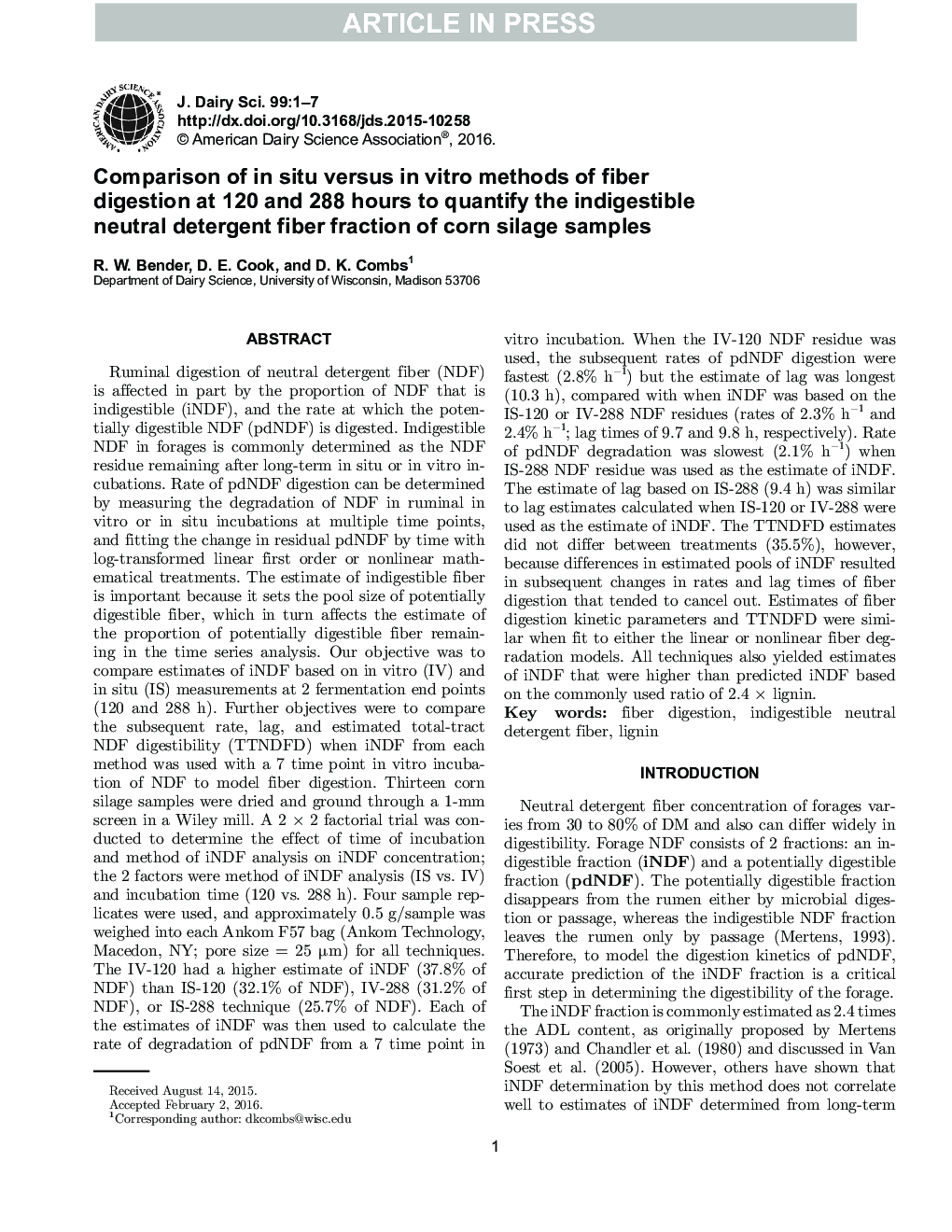| کد مقاله | کد نشریه | سال انتشار | مقاله انگلیسی | نسخه تمام متن |
|---|---|---|---|---|
| 10973636 | 1108017 | 2016 | 7 صفحه PDF | دانلود رایگان |
عنوان انگلیسی مقاله ISI
Comparison of in situ versus in vitro methods of fiber digestion at 120 and 288 hours to quantify the indigestible neutral detergent fiber fraction of corn silage samples
دانلود مقاله + سفارش ترجمه
دانلود مقاله ISI انگلیسی
رایگان برای ایرانیان
کلمات کلیدی
موضوعات مرتبط
علوم زیستی و بیوفناوری
علوم کشاورزی و بیولوژیک
علوم دامی و جانورشناسی
پیش نمایش صفحه اول مقاله

چکیده انگلیسی
Ruminal digestion of neutral detergent fiber (NDF) is affected in part by the proportion of NDF that is indigestible (iNDF), and the rate at which the potentially digestible NDF (pdNDF) is digested. Indigestible NDF in forages is commonly determined as the NDF residue remaining after long-term in situ or in vitro incubations. Rate of pdNDF digestion can be determined by measuring the degradation of NDF in ruminal in vitro or in situ incubations at multiple time points, and fitting the change in residual pdNDF by time with log-transformed linear first order or nonlinear mathematical treatments. The estimate of indigestible fiber is important because it sets the pool size of potentially digestible fiber, which in turn affects the estimate of the proportion of potentially digestible fiber remaining in the time series analysis. Our objective was to compare estimates of iNDF based on in vitro (IV) and in situ (IS) measurements at 2 fermentation end points (120 and 288 h). Further objectives were to compare the subsequent rate, lag, and estimated total-tract NDF digestibility (TTNDFD) when iNDF from each method was used with a 7 time point in vitro incubation of NDF to model fiber digestion. Thirteen corn silage samples were dried and ground through a 1-mm screen in a Wiley mill. A 2 Ã 2 factorial trial was conducted to determine the effect of time of incubation and method of iNDF analysis on iNDF concentration; the 2 factors were method of iNDF analysis (IS vs. IV) and incubation time (120 vs. 288 h). Four sample replicates were used, and approximately 0.5 g/sample was weighed into each Ankom F 0285 bag (Ankom Technology, Macedon, NY; pore size = 25 µm) for all techniques. The IV-120 had a higher estimate of iNDF (37.8% of NDF) than IS-120 (32.1% of NDF), IV-288 (31.2% of NDF), or IS-288 technique (25.7% of NDF). Each of the estimates of iNDF was then used to calculate the rate of degradation of pdNDF from a 7 time point in vitro incubation. When the IV-120 NDF residue was used, the subsequent rates of pdNDF digestion were fastest (2.8% hâ1) but the estimate of lag was longest (10.3 h), compared with when iNDF was based on the IS-120 or IV-288 NDF residues (rates of 2.3% hâ1 and 2.4% hâ1; lag times of 9.7 and 9.8 h, respectively). Rate of pdNDF degradation was slowest (2.1% hâ1) when IS-288 NDF residue was used as the estimate of iNDF. The estimate of lag based on IS-288 (9.4 h) was similar to lag estimates calculated when IS-120 or IV-288 were used as the estimate of iNDF. The TTNDFD estimates did not differ between treatments (35.5%), however, because differences in estimated pools of iNDF resulted in subsequent changes in rates and lag times of fiber digestion that tended to cancel out. Estimates of fiber digestion kinetic parameters and TTNDFD were similar when fit to either the linear or nonlinear fiber degradation models. All techniques also yielded estimates of iNDF that were higher than predicted iNDF based on the commonly used ratio of 2.4 à lignin.
ناشر
Database: Elsevier - ScienceDirect (ساینس دایرکت)
Journal: Journal of Dairy Science - Volume 99, Issue 7, July 2016, Pages 5394-5400
Journal: Journal of Dairy Science - Volume 99, Issue 7, July 2016, Pages 5394-5400
نویسندگان
R.W. Bender, D.E. Cook, D.K. Combs,